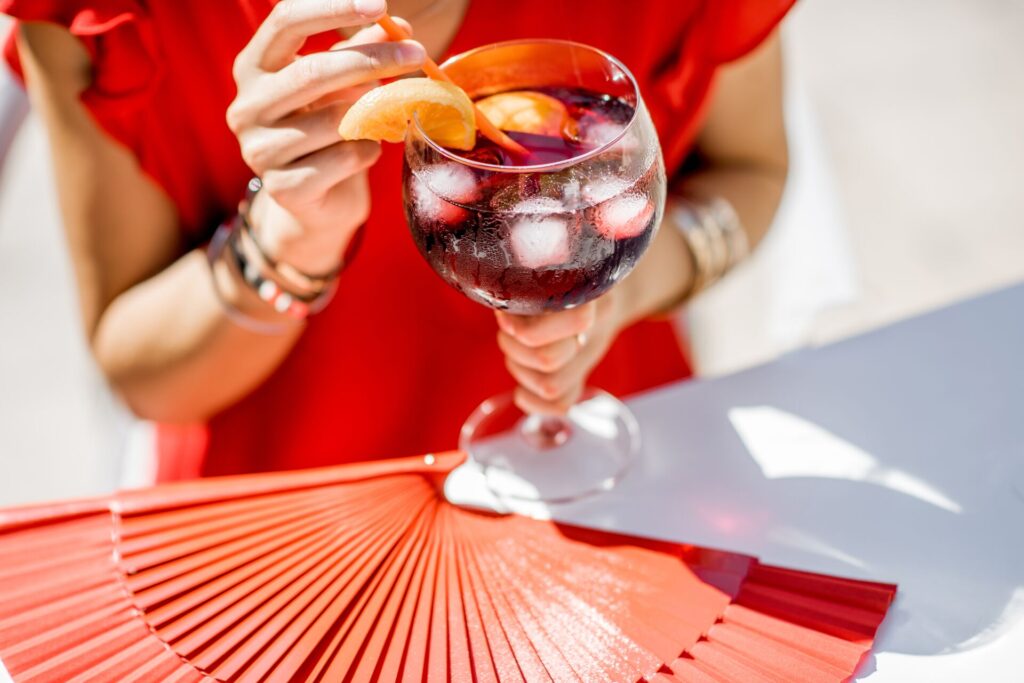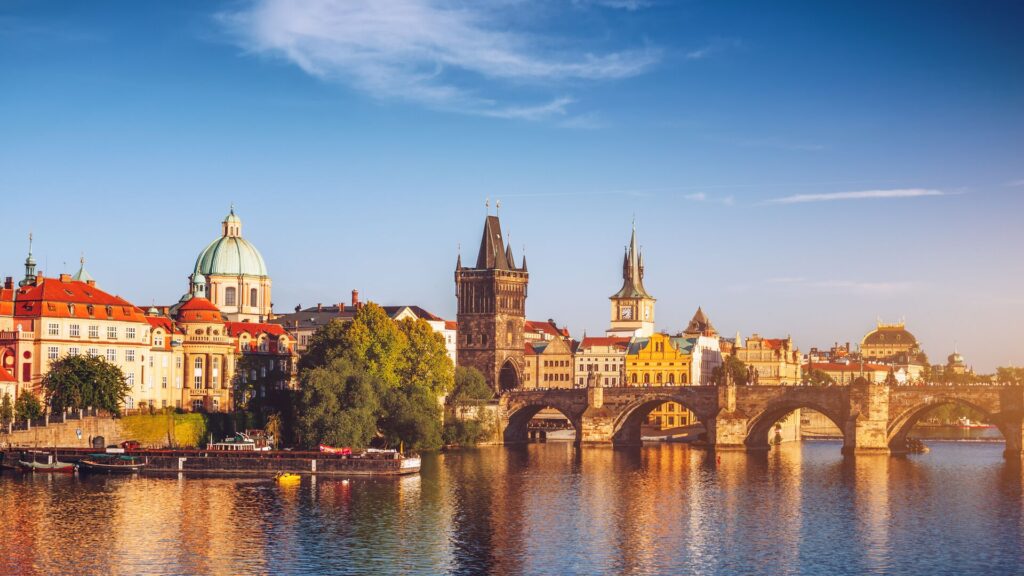Sunshine, siestas, fiestas and tapas. I think we all can agree that in Spain they know how to enjoy life. One of the many delightful aspects of this vibrant country is its array of traditional Spanish drinks. From the refreshing sweetness of sangria to the crisp tartness of sidra, these beverages capture the essence of Spanish culture and the country’s diverse regions.
If you are wondering what to drink in Spain, or just looking for travel inspiration, read on for a flavorful journey through ten popular Spanish drinks. Plus find out how to make them to be instantly transported to a sun-soaked plaza or golden beach one sip at a time. While you read, just imagine joining us on a Spain guided tour.

What is the national alcoholic drink of Spain?
Although there is no official national alcoholic drink of Spain, many will say Sangria. However, despite its global popularity and common association with Spain, it is widely understood that this is more a drink for visitors. Many people would say that, among the locals, it is Spanish sherry wine or vino de Jerez as it is also known.
What is a Spanish drink that’s non-alcoholic?
Hortacha is a name given to a drink that is generally plant based, but sometimes contain milk. In Spain, it is made with soaked, ground, and sweetened tiger nuts (more on that below). Historical records suggest that horchata originated with the Ancient Egyptians, who crafted a barley-based drink. However, the widely recognized version of horchata today comes from Valencia, Spain. When the Moors invaded Spain in the 8th century, they brought the Egyptian recipe with them. In Valencia, where sweet tiger nuts were plentiful, locals creatively transformed the Moorish drink into a refreshing Spanish beverage made from tiger nuts, resulting in the beloved horchata de chufa.
Sangria
Ooozing everything that is great about Spain, this earliest version of this lush, fruity beverage date back to over 2,000 years ago. The Romans planted vineyards as they conquered the Iberian Peninsula, and because it was not safe to drink water, they often fortified it with wine, spices, and herbs.
Though there are many interpretations of what “traditional sangria” is, but this famous Spanish drink typically requires fruit, sugar, orange juice, liquor and red wine as its main ingredients. Put fruit such as apples and oranges together with a sweetener like brown sugar into a large jug or pitcher and mix together. Next add orange juice and a liquor such brandy or rum. Mix and taste as you go. Finally add a bold red Spanish wine followed by some ice to chill.
Tinto de Verano
More popular with the locals than sangria, the similar drink tinto de verano (Spanish for ‘red wine of summer’) is a refreshing and easy-to-make red wine cocktail. Requiring only two base ingredients – wine and soda – you really can’t go wrong. A fruity medium-bodied red wine is recommended, along with a lemon lime soda. La Casera a Spanish lemon-flavored soda is traditional, but you can make a lovely beverage with Sprite or 7Up if needed.
If you want to jazz up this Spanish alcoholic drink a bit you can substitute half the wine with Vermouth, fill the glass up with fresh fruit such as kiwis, strawberries and peaches, or swap the red wine for dry sherry and garnish with mint and lemon slices to create its sister drink from the south, a Rebujito.
Horchata de Chufa
Horchata de Chufa, one of Spain’s most famous non-alcoholic drinks, is originally from the southwestern region of Valencia. Refreshingly delicious, its also naturally gluten free and dairy free. It’s made from ground chufa nuts (‘tigernuts’ in English), which aren’t actually nuts at all. In fact they’re the roots of a wetland plant called a sedge and have been cultivated for centuries and eaten as a chewy snack or ground into a flour. The tiger nuts are soaked in water then blended. Lemon and cinnamon are often added for a little flavor.
Queimada
Queimada, known as the “fire drink,” hails from Galicia in the northwest. This Spanish alcoholic drink is a traditional punch crafted from Galician aguardente, a spirit that is distilled from the remnants of winemaking, known as orujo. It is then sweetened with sugar and enhanced with lemon or orange peel, along with coffee beans. Some versions of queimada might also feature cinnamon or apples and is commonly made in a hollowed-out pumpkin or in a ceramic or clay pot.
Many Spanish traditional drinks come with a story, and this doesn’t disspoint. Queimada is a traditional ritual practiced by the people of Galicia, situated in the northwestern corner of Spain, just across from Portugal. This ceremony aims to banish demons and evil spirits through a combination of incantations and a witch’s brew crafted from Orujo.
Tepache de Pina
A slightly fermented drink made from fresh pineapple peel and core, the Tepache de Pina is hailed as one of the most refreshing beverages you might encounter. Its unique in that it takes advantage of parts of the fruit that we usually just throw away or compost, mixing pineapple peels with sugar, and water. Its not a quick drink to make but a fun challenge for the more ambitious host.
First dissolve the sugar, (traditionally, piloncillo sugar is used to make tepache but you can use dark or light brown sugar as an alternative), put it into a glass jar then pack with pieces of pineapple rind. Adding cassia bark and smash the cloves enhances the flavour. Making sure the pineapple is fully submerged and leave it for three days. Strain the mixture and leave for a further two days before chilling in the fridge and serving.
Kalimotxo
Kalimotxo, or calimocho is made with red wine and Coca-Cola. A simple and refreshing combination, the idea for this drink appeared in the early 20th century, but it only became popular around the 1970s. East to prepare, its sweet taste is quickly followed by a wine aftertaste.
There’s a well-known story that tells of festival organizers in the Basque region who decided to make kalimotxo in order to use up a surplus of leftover, unpleasant red wines. To their surprise, the concoction became a huge hit, and this blend of half red wine and half soft drink truly captured the public’s attention.
The name kalimotxo features the suffix -motxo, which translates to “ugly.” This could either reference the drink’s dark color or the circumstances surrounding its creation.
Agua de Valencia
Agua de Valencia is a delightful Spanish cocktail that combines freshly squeezed orange juice, cava (sparkling wine), vodka, and gin. This fruity, refreshing Spanish alcoholic drink is a perfect blend of a mimosa and sangria, evoking the essence of Spain on a sunny spring day.
Simply juice the oranges, mix in your alcohol and you’re set to serve. Keep in mind that the longer Agua de València sits in the refrigerator, the more the flavors will harmonize.
Vermouth
When in Spain, do as locals do which means sipping vermouth on a Sunday afternoon. Traditionally served as an aperitif before lunch, vermouth was introduced to Spain in the late 19th century via Italy and quickly became immensely popular and distinctly Spanish.
This sweet wine can be either red or white wine, though red is more common, and it’s typically accompanied by an olive or a slice of orange. While there are various types of vermouth, the sweet red variety is the one you’re most likely to encounter in Spain, offering a bold contrast to the dry vermouth you may be more familiar with in other countries.
Granizado
On a scorching summer day, nothing beats a granizado made with crushed ice and fresh fruit juice or syrup. One of the most refreshing of Spanish traditional drinks, here are countless flavors to choose from, but one of the favorites is lemon—crafted with lemon juice, sugar, and shaved lemon peel for an extra zing. You’ll find granizados available throughout Spain, in places ranging from ice cream shops and grocery stores to bars and cafes.
Sidra
Albeit not a drink you can make, Spanish cider (sidra) deserves a mention. This famous Spanish drink produced in the northwest regions of Spain and the Basque country dates back to the 1st century. A rich, cultural tradition, to make sidra native apples are harvested in early autumn and fermented for several months with their natural yeasts.
This drink comes with its own way of drinking, In Asturias, glass was historically a luxury item that was not easily accessible. As a result, friends and family often shared a single glass while enjoying cider together, fostering a communal atmosphere over time. This practice developed into a distinctive drinking ritual. Typically, after taking a sip, one would leave a small amount of cider in the glass. Then, to “clean” the glass, the last sip would be poured onto the ground from the side that touched their lips before passing the glass to the next person for their turn.
Why not join us for a Spain guided tour and discover more of this beautiful country in “Business Class” style?





